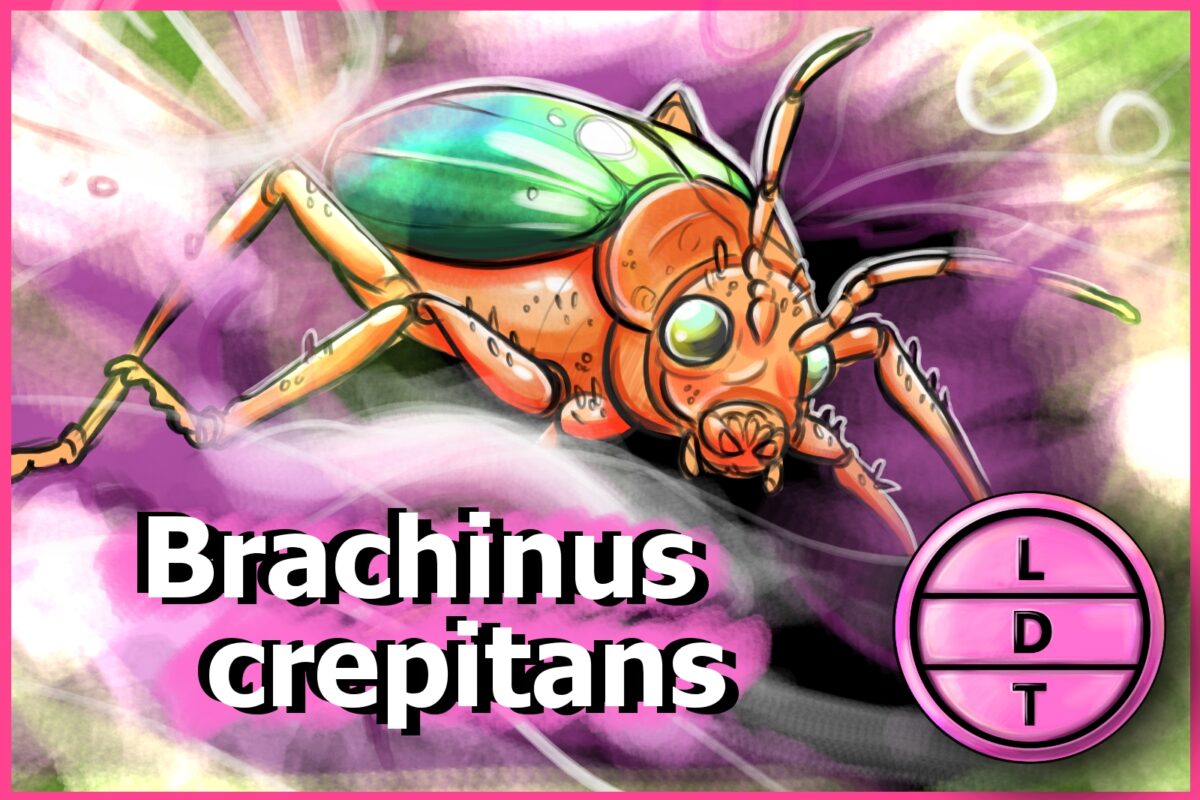“Today we’re talking about bug spray… in a manner of speaking. But more on that later.”
When you’re a small beetle in a big world, you can easily become someone’s lunch if you’re not careful. So having a secret weapon is vital to survival. When danger rears its ugly head, the bombardier beetle rears its rear to give a nasty chemical surprise to any hungry eyes that might want an easy snack. It just goes to show that paying attention in chemistry class can save your life. But sometimes you just gotta give your enemies the business here in Life, Death, and Taxonomy.
Description of the Bombardier Beetle
- Bombardier beetles come in several varieties, but most have a large abdomen, long thorax, and small head.
- Looking at it, you may assume that it’s mostly abdomen, but it’s wings conceal half of it’s thorax, which is about the same length as it’s abdomen.
- Our friend the crepitans has a shiny dark green elytra and a red orange body.
Measure up
Welcome to the beloved Measure Up segment. The official listener’s favorite part of the show! The part of the show when we present the animal’s size and dimension in relatable terms through a quiz that’s fun for the whole family. It’s also the part of the show that’s introduced by you when you send in audio of yourself saying, singing, or chittering the words Measure Up into ldtaxonomy at gmail dot com. We do have a new Measure Up from Nora. She also said her favorite animal is the “noble, idiotic dairy cow.”
Length
- 7–10.2 millimetres (0.28–0.40 in)
- How many bombardier beetles go into the length of Optymistychna Cave, the longest gypsum cave in the world?
- Hint: The cave is in Korolivka, Ukraine and it was discovered in 1966. It’s situated between layers of 20 meter thick gypsum.
- 23,126,400 beetles.
- So far, the cave has been mapped to be 236 km (146 miles).
Weight
- 7 milligrams (estimated)
- How many bombardier beetles go into a large male hucul pony?
- Hint: A hucul pony is also called a Hutsul or carpathian pony that was first bred by the Hutsul people of Ukraine. The first domestic horses were probably domesticated in Ukraine 6,000 years ago.
- 65,576,496 beetles.
- The hucul pony is between 880 to 1210 pounds with stallions being on the upper end of average.
Fast Facts Bombardier Beetle
Bombardier Beetles are a group that’s also called ground beetles, of which there are more than 500 species.
The bombardier beetle lives in the steppes of the Podolian Province of Ukraine. It’s also found in the UK, especially in southern England and Wales. It’s also dispersed throughout Europe. They prefer dry sunny areas of grasslands and plains. But they may be found under rocks, in train yards, farmland, and rock quarries.
The species goes through several instars, but it’s lifecycle isn’t completely understood. Larvae are believed to be parasites that attach to other beetle larvae and consume it over several instars.
The bombardier beetle is something called irreducible complexity, and we’ll talk about why in a minute. But irreducible complexity is a term that’s debated between naturalists and the theory of intelligent design. It’s offered as a counterpoint to slow, gradual evolution.
Irreducible complexity is a concept that says a system cannot be made any less complex and still be functional. The primary example that’s usually pointed to is the bacterial flagellum. Apparently bacterial flagellum has what is essentially a little motor that would not work if a part was reduced or removed.
If something is irreducibly complex, then it poses a threat to the concept of unguided, gradual evolution. The big point of contention is usually whether or not something can or can’t be reduced and still function.
Major Fact: Acid Bombs
The bombardier beetle has a pretty unique defense mechanism that is anything but basic.
When predators like ants, spiders, praying mantises, or frogs threaten the bombardier, it hikes up its glands and gives it a nice and potentially fatal spritzing of a different kind of chemotherapy.
The beetle has two acid glands at the end of its bum that are lined with special cells that secrete a special mixture of enzymes. This is connected to a compressible chamber containing chemicals including hydrogen peroxide.
When it’s threatened, the beetle turns the not-so-cold shoulder to the predator and compresses the chemical chamber to squeeze those good chems into the enzyme glands.
The enzymes immediately break down the hydrogen peroxide and other chemicals into a substance called benzoquinone.
This chemical reaction releases a lot of energy and heat – getting up to 212 degrees Fahrenheit and turns it into a not nice-smelling vapor.
Then, with a loud pop, out comes a bunch of superheated vaporized benzoquinone that irritates the eyes and respiratory systems of the predators – sometimes enough to kill them.
The spray is made possible by 70 compressions of the reservoir in a fraction of a second. The pressure on the reservoir creates “microexplosions” that open and close the valve between the reservoir with the hydrogen peroxide and the glands with the enzymes.
Some beetles can swivel their glands 270 degrees to spray in most directions.
Ending: So know your chemistry, keep your glands on a swivel, and use superheated acid to your advantage like the bombardier beetle here in Life, Death, and Taxonomy.

